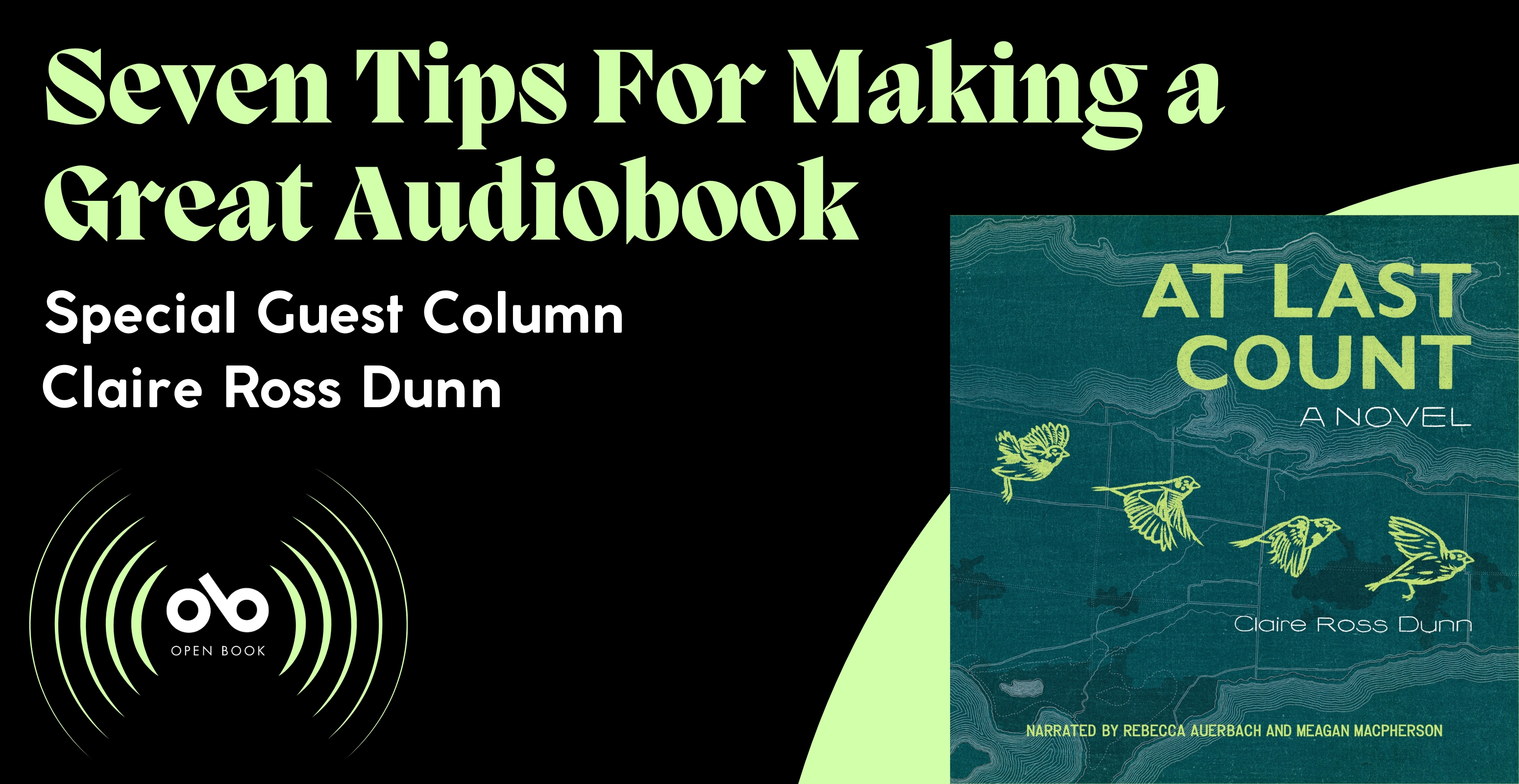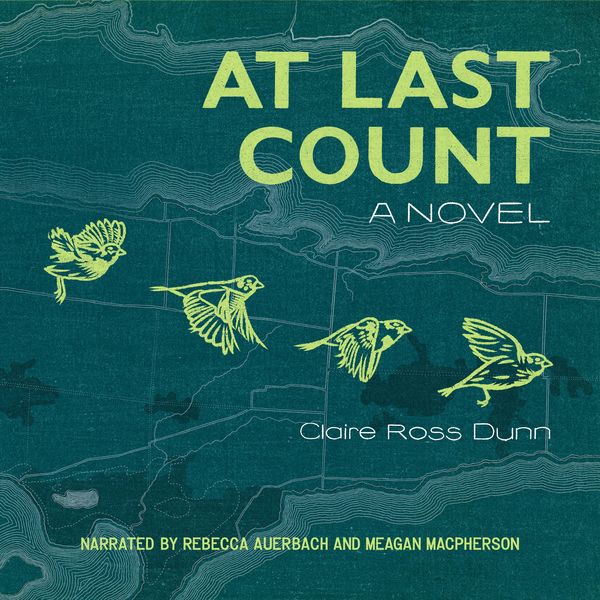Seven Tips For Making a Great Audiobook
By Claire Ross Dunn
My first novel, At Last Count (Invisible Publishing, 2022) was recently turned into an audiobook. This is what you hope for as a writer, because it offers a great second way to reach readers—third, if you count e-book sales. Booknet Canada reports that almost half of all Canadians listened to audiobooks in 2021. Who doesn’t want their book to be part of that?
I reached out to three people involved in At Last Count’s audiobook production to share their advice, and added some of my own. Note: audiobooks are usually paid for by the publisher. I’m covering what happens after you get the greenlight, rather than the process leading up to it.
Find a hook.
At Last Count is a coming-of-age tale for adult readers about a Toronto woman who is losing her apartment to condos—particularly challenging because she struggles with OCD, and being displaced is a trigger. She soon discovers the only person who can help reclaim her family homestead in rural Ontario is her childhood nemesis…and secret crush.
Although I wrote the book for adult readers, Invisible Publishing and I had heard that teens and young adults were loving it too, because the story is told in two time periods, “now,” when the protagonist, Paisley, is 39 and, “then,” when she’s 13. Invisible’s publisher, Norm Nehmetallah, and I came up with the idea of having two actors narrate the book. We hope it will help the audiobook stand out in the marketplace. Is there a high-concept idea you can think of to anchor your audiobook?
Get a great director.
Our audiobook was directed by Beverley Cooper, who was an actor, and is now a playwright and audiobook director. She has directed over thirty titles, including books by Margaret Atwood, Miriam Toews, Tanya Tagaq, David A. Robertson, Marina Endicott and many others.
About directing an audiobook, Beverley says: “Find the right tone and pace. Often people are listening to books while they are doing other activities—walking, driving, making dinner—and it takes a moment for the words to be fully absorbed. You don’t want to hurry the experience of listening to a book, or feel like the narrator is rushing. Some books require broad character voices and accents, while others require a softer kind of story-telling.”
Because Beverley has experience in the theatre, she knew how to communicate with actors, and because she’s a writer herself, she understands the inner workings of the text. She feels her job is to “make sense of the story for the listener, with authenticity of voice, correct pronunciations, and understanding the author’s intention… The story is everything.”
Your CanLit News
Subscribe to Open Book’s newsletter to get local book events, literary content, writing tips, and more in your inbox
I knew my book was in the hands of one of the best audiobook directors around. See if you can vie for a director you trust and with whom you connect. It makes all the difference.
Write strong character descriptions for casting.
Take the first crack at writing the character descriptions for casting. Use emotional words to describe your characters—how you’d like them to feel to the listener.
Cassie Smyth, Audiobooks Manager for ECW Press, which produced my audiobook for Invisible Publishing, says: “Not only does having specific casting criteria and a creative vision for an audiobook help the producer, but it also helps agents and prospective narrators decide whether they should toss their hat in the ring for a given project. In doing so, we streamline the process, so we receive auditions from voice actors that meet our criteria, which is then further refined when we make our selection as to who should narrate the audiobook.”
“Get the right narrator,” adds Beverley. “The correct voice for the book is paramount: a voice you want to spend time with, have whisper in your ear, who lifts the words off the page, creating the images and emotions in your mind but still allows the listener to bring their own imagination to the book.”
We cast Rebecca Auerbach for Paisley at 39, and Meagan MacPherson for Paisley at 13. They both gave wonderful performances.
Be available for consultation.
“The person most familiar with a book is, of course, its author,” says Cassie Smyth. “By connecting the narrator with the author, a direct line of communication is opened up so the narrator can ask deeper questions about the characters, their circumstances, specific plot points, and more. When the narrator has a better understanding of the content they're trying to portray, it makes for a better performance and, in turn, a better listening experience for audiences.”
I was in frequent consultation with Norm, Beverley, and the actors, either by phone, text or through a Q&A Google sheet to which everyone had access. Everyone was in the loop and felt part of a cohesive team.
Be timely.
You don’t want to be the impediment to getting your audiobook out there. The turnaround between phases can be tight, so I made sure I was available to provide pronunciations, chat with the director if she had questions, and vet the recording once it was available.
“It's important that everyone is on the same page when it comes to production scheduling and planning,” says Cassie. “Making sure everyone has all of the information they need ahead of time means that they don't have to worry about logistics and can focus instead on delivering a captivating performance.”
Share your audiobook with schools.
“If you’re going to market your book to schools, know that the availability of an audiobook is a strong asset from an equity perspective,” says Norm Nehmetallah. “Teachers like to be able to offer both e-books and audiobooks as alternative ways for students to enjoy a book.”
We are sharing the news of the book, and audiobook, with Superintendents of school boards, the heads of English departments, and librarians. It’s effortful, but the payoff can be enormous if a school board buys multiple of copies of your book for classroom use.
Promote your audiobook’s release.
Anything you do to promote your book will also promote your audiobook, but here are a few simple things you and your publisher can do to ensure the audiobook gets good exposure:
- Make sure all the links to retailers are working on your author website, the publisher’s website, and any other promotional text that gets out there.
- Include a link to your audiobook in your email footer to share the news with people with whom you’re not connected on social media.
- If you’re using a postcard to promote your book, you can add a QR code label to link to the webpage where people can buy the audiobook, or to the trailer on YouTube.
- Ask your team (director, narrator(s), etc.) to share news of the audiobook—they likely have a following, and can add to your reach.
- Share an audiogram on social media. An audiogram is a clip of your audiobook with a branding image (perhaps your book cover) and a waveform visual. The length of audiogram allowed varies from platform to platform, so make sure to have snippets of different lengths for Twitter, Facebook, Instagram, Tik Tok and YouTube. Also, you may need a square image for one platform, and a landscape or portrait image for another.
Here’s our audiogram so you can get a taste of what we made—a clip from both a “now” and “then” section:
ALC (Now - Page 57) (IG Post).mp4
ALC (Now - Page 57) (Twitter).mp4
At Last Count (Then - Page 83) (IG Post).mp4
ALC (Then - Page 83) (Twitter).mp4
I was thrilled with the At Last Count audiobook recording process, and am equally thrilled with the result. I hope you have just as great an experience making yours.
The views expressed by Open Book columnists are those held by the authors and do not necessarily reflect the views of Open Book.
Claire Ross Dunn is the author of At Last Count, a Globe and Mail Best Book of 2022 and a Toronto Star 2022 Pick. She has been awarded Canada Media Fund early development financing to adapt At Last Count into a one-hour drama TV series. The audiobook is available through Invisible Publishing, or any online bookstore, including Storytel, Kobo, Amazon, and Booktopia (in Australia).






